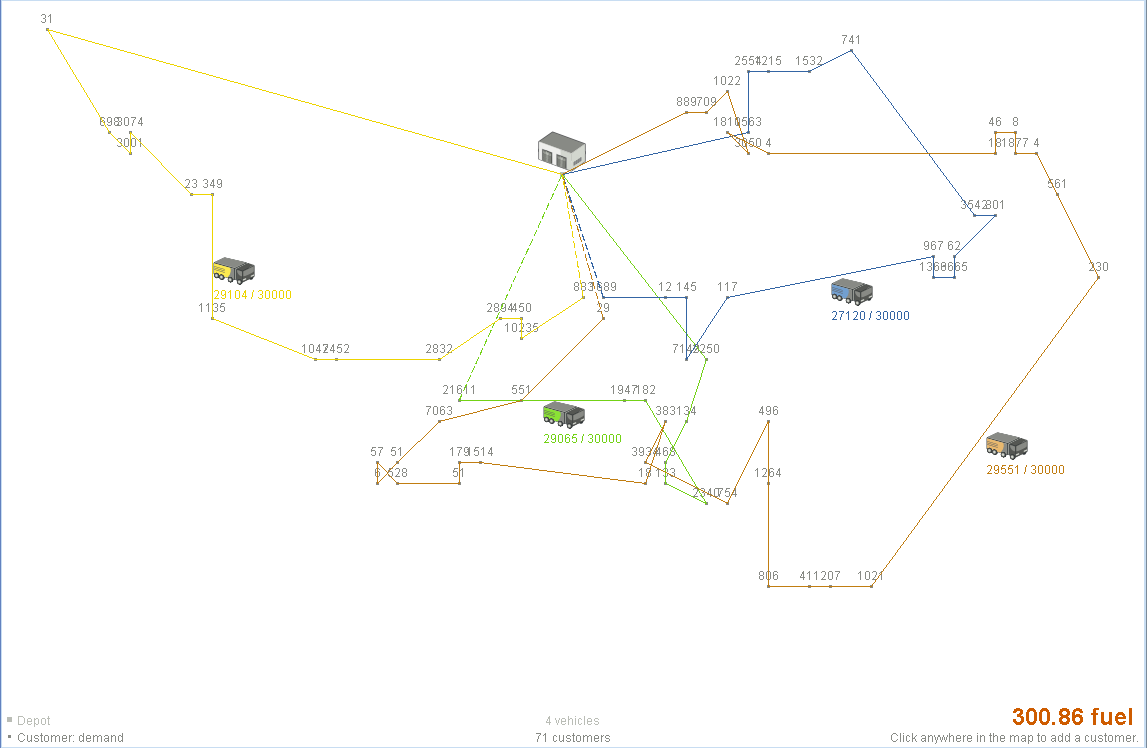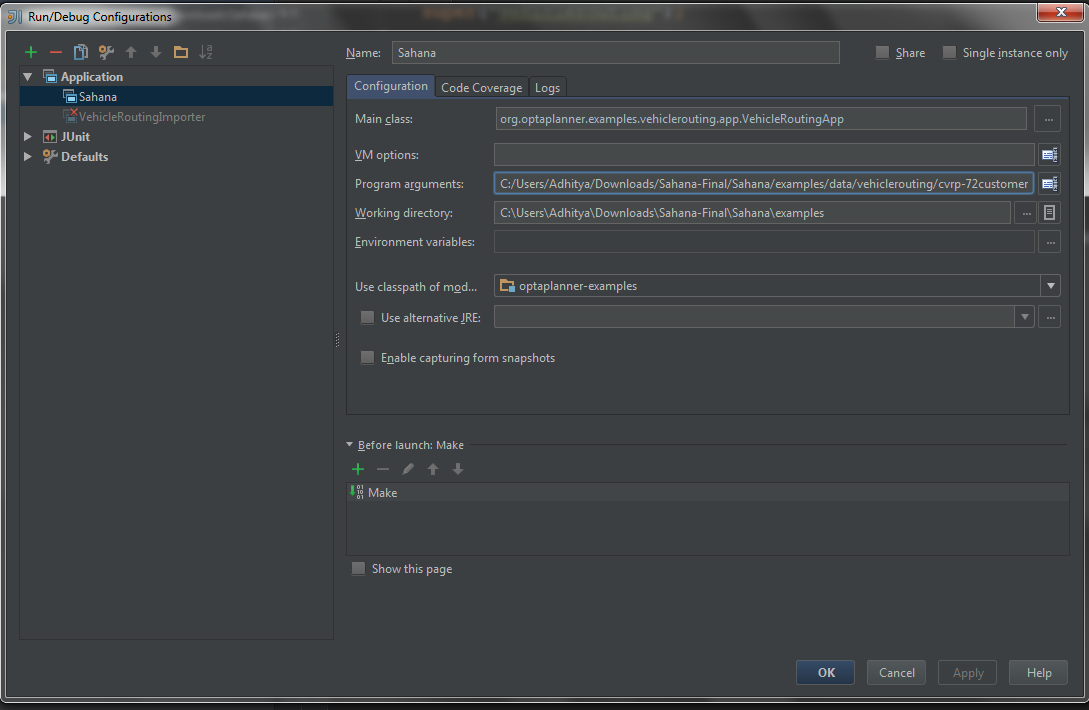| Version 30 (modified by , 11 years ago) ( diff ) |
|---|
BluePrint: Vehicle Routing
Table of Contents
Introduction
Vehicle Routing tries to determine possible (optimal) routes for the transportation of resources from warehouses to facilities.
Problem class definitions:
- http://en.wikipedia.org/wiki/Vehicle_routing_problem
- http://neo.lcc.uma.es/vrp/vehicle-routing-problem
Stakeholders
Users
- Supplier (Warehouse) (includes Warehouse Manager, Fleet Manager, Finance Officer)
- Shelter (includes Volunteers at Shelter)
- Transport Staffers (Driver)
Who are affected?
- Sahana Developers - Few of the models, should be tweaked
- Warehouse - Extra information to be provided about capacity of vehicles
- Transport Staffers - Additional communication about routes to be taken
- Volunteers at Shelter - Additional data, about arrival time(s) of resources
User Stories
- Supplier can determine which items will be delivered by which vehicle (in order to load the vehicles accordingly)
- Supplier can determine a possible (efficient) route for each vehicle to deliver the requested items
- Supplier can determine the costs/time for the delivery
- Requester can be given an estimated time of arrival of the requested items
- Driver receives the route for the delivery
Requirements
<Group requirements in subsections, e.g. etc.> <http://en.wikipedia.org/wiki/Requirements_analysis requirements> <Identify different types of requirements:>
Functional
Non-functional
http://en.wikipedia.org/wiki/Non-functional_requirements
Interoperability
Standards
System Constraints
Design
<Where relevant include alternative design options>
Data Model
(e.g. EER or class diagrams)
Workflows
- Request for resources, has come into the database (some generic request, by anyone)
- Warehouse manager, gets the details of the shelters and resources to supply
- Fleet Manager, supplies to the warehouse, with vehicles
- VRP Module is run upon
- This gives the following output
- Route for each vehicle
- Cost per vehicle
- Resources in each vehicle
- Time to reach shelter, by each Vehicle
- Cost per vehicle, is given to Finance Officer, for approval
- Route and Cost per vehicle, is given to each Driver
- Time to reach shelter, by each Vehicle, is given to respective Volunteers
- Journey begins
Site Map
<for User Interface solutions>
Wireframes
<for User Interface solutions>
Technologies
Current Implementation
This implementation is entirely based on the examples provided by OptaPlanner: https://github.com/droolsjbpm/optaplanner/tree/master/optaplanner-examples/src/main/java/org/optaplanner/examples/vehiclerouting
The main method of this module is present at: https://github.com/wolfshadow18/Vehicle-Routing-Problem/blob/master/Sahana-Final/Sahana/examples/sources/src/main/java/org/optaplanner/examples/vehiclerouting/app/VehicleRoutingApp.java
This main method takes an argument, which is a path for an unsolved Capacitated Vehicle Routing Problem, which is in the form of an XML file.
Examples of unsolved XML files, can be seen here: https://github.com/wolfshadow18/Vehicle-Routing-Problem/tree/master/Sahana-Final/Sahana/examples/data/vehiclerouting[[BR]] This unsolved XML file has the following main attributes:
- Location List (Longitude and Latitude)
- Warehouse List (With a reference to a Location in the Location List)
- Vehicle List (Stating the Capacity and the location of the Vehicle)
- Customer List (Stating the Demand of each of the locations)
When such an XML file is passed to the module it returns back a Solved XML file, which is stored in the same directory as the unsolved file, which was passed earlier, with the prefix – “solved-”
This XML file, has to be parsed by the modules in Sahana, and should be utilised upon.
The final Solved file, diagrammatically, looks similar to this. This Solved file, tells which Vehicle should go to which Location(s), in which order. Such an example, can be seen here: https://github.com/wolfshadow18/Vehicle-Routing-Problem/blob/master/Sahana-Final/Sahana/examples/data/vehiclerouting/solved-cvrp-72customers.xml
To Test the module, perform the following steps:
- Download a copy of the module, which is currently being hosted at, https://github.com/wolfshadow18/Vehicle-Routing-Problem/
- Download IntelliJ Idea/ Netbeans. It is recommended to use the former.
- Open pom.xml, which is located at examples/sources/ from the IDE
- While setting up for the first time, it may take some time, as it needs to download its Maven dependencies.
- After which, set up a Run configuration, for this project. Please look at the image below. The program arguments, should ideally contain the path of the unsolved file, that you wish to pass to the module.
- Go to Sahana/examples/sources/src/main/java/org/optaplanner/examples/vehiclerouting/app/VehicleRoutingApp.java, and run the project.
- Troubleshooting: In case, an error such as- “The working directory should be set to the directory that contains the data directory (which is not the data directory itself) “ pops up, please check whether your working directory is the same as mentioned above.
- You would notice that, in the console, the program has started running, typically, for testing purposes; the running time of the module has been limited to 1 minute. However, this can be increased, by changing, /examples/sources/src/main/resources/org/optaplanner/examples/vehiclerouting/solver/vehicleRoutingSolverConfig.xml
- In this file, find the attribute minutesTimeSpent, and change it to a positive integer. This can be done whenever necessary as all the attributes of this file, have methods in which they can be accessed.
Few points to be noted:
- As solving time of the problem is increased, more efficient results can be obtained.
- The file is returned back to the user using the function, getOutputFile(), which is also present in VehicleRoutingApp
Planned Implementation
Given
- A transportation network
- A single supplier, having a fleet of vehicles of given capacities, and a warehouse of goods
- A set of demands (who, what, when)
Assumptions
- All routes in the transportation network, are accessible
- Sufficient vehicles
- Sufficient drivers
- Sufficient fuel
- Vehicles transport all the fuel they need for transport
- Minimizing total distance also minimizes delivery time
Goal
- Satisfy all demands within their time windows
- Minimize total distance
Future Extensions
- Multiple Warehouses
- Minimize fuel consumption
- Maximize the number of demands satisfied
- Handle routes that suddenly become unavailable
- Re-optimization of plan if routes become available again, without sending vehicles home
- Handle different types of routes
- Handle case of too few vehicles to transport all in one shot
- Low fuel at start
- Low fuel availability within the network to refuel vehicle
- Handle time for loading/unloading
- Handle breakdowns of vehicles
- New demands coming in over time
- Assignment of drivers to vehicles
Outstanding Questions
<Questions about the features or design that haven't been (and need to be) answered>



